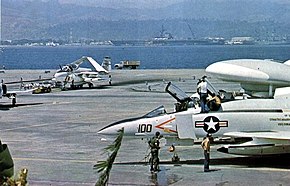Carrier Air Wing Fifteen
This article needs additional citations for verification. (September 2022) |
| Carrier Air Wing Fifteen | |
|---|---|
 | |
| Active | 20 December 1963 – 31 March 1995 (As CVW-15) |
| Country | United States |
| Branch | United States Navy |
| Type | Carrier air wing |
| Engagements | Korean War (as CVG-15) Vietnam War |
Carrier Air Wing Fifteen (CVW-15) is a former United States Navy aircraft carrier air wing that was decommissioned on 31 March 1995. It was previously known as Carrier Air Group Fifteen (CVG-15) before 1963 before being renamed in December of that year.
History[edit]
Early years and Vietnam War[edit]

Carrier Air Group 15 was established on 5 April 1951, and was deployed to the Korean War in September of that year on board the USS Antietam. The squadron was made up of reserve squadrons during the two cruises during the Korean War. Starting in 1960, CVG-15 would begin a two decade long attachment with the USS Coral Sea that would continue when in 1963,[citation needed] all CVGs were re-designated as Carrier Air Wings.[1] With this, CVG-15 became Carrier Air Wing 15. CVW-15 however did deploy with the USS Constellation only once in 1966 during the Vietnam War. During the evacuation of Saigon in 1975, CVW-15's aircraft covered the helicopters used to rescue the civilians fleeing the Invasion.
Post Vietnam[edit]

CVW-15 made their final deployment on board the Coral Sea in 1977. This cruise was the only time that the F-4J Phantom and EA-6A Electric Intruder part of CVW-15. After this, in 1979, CVW-15 deployed for the first on a different carrier than Coral Sea in around 13 years when they deployed with USS Kitty Hawk and with new F-14A Tomcat and S-3A Viking.
In 1983, CVW-15 deployed on the new Nimitz-class carrier USS Carl Vinson's first post-shakedown cruise.[citation needed] This cruise was significant as it was an around the world cruise that involved stops in St. Thomas, Monaco, Abidjan, Perth, Subic Bay, British Hong Kong, Sasebo, Pusan, Pearl Harbour and the moving the Vinson's homeport from Norfolk, Virginia on the west coast to Alameda, California, in the San Francisco Bay Area.[2] During their time with the Carl Vinson, they took part in RIMPAC 84' and 86'.[citation needed] During the 1986-to-1987 cruise in the North Pacific, VF-51 and VF-111 carried the multiple tail codes of other carrier air wings to confuse Soviet Naval Aviation patrols which carrier VF-51 and 111 was assigned to.[3]
In July 1988, during the Olympics in Seoul, CVW-15 embarked on board Carl Vinson and operated off the coast of South Korea.[4] In 1989, they also took part in the large naval exercise PACEX 89.[citation needed]
Post Cold War and Final years[edit]
In 1990, CVW-15 made their last cruise with the Carl Vinson before moving back to the Kitty Hawk for the rest of their remaining service in the US Navy. This cruise was also the last cruise for the A-7 Corsair in CVW-15 before VA-27 and VA-97 converted to the F/A-18A as well for the SH-3H Sea King which was replaced by the SH-60F Oceanhawk/HH-60H Rescuehawk in the case of HS-4.
On 13 January 1993, VFA-97's CDR. Kevin J. Thomas led a night air strike of 110 coalition aircraft, including 35 aircraft from the Kitty Hawk, against Iraq SAM Command and Control sites in Southern Iraq. This in response to Iraqi violations of U.N. resolutions. On the 18th, an airstrike made of 29 aircraft including F/A-18As and F-14As and E-2Cs in support from CVW-15 was called off when Iraq moved mobile SAM sites into Southern Iraq.[5]
On the 23rd, another incident occurred when Iraqi AAA fired on an A-6E SWIP Intruder from VA-52 and two F/A-18As from CVW-15 over Southern Iraq. In response, the Intruder attacked the AAA site with a 1,000 pound bomb.[5]
Between June and December 1994, CVW-15 made their last deployment before being inactivated in 1995 along with many squadrons that were part of CVW-15.[citation needed] During that deployment, the air wing participated in the "first anti-submarine warfare prosecution of Chinese Han class sub contact" as well as the tracking of the larger Oscar II Class Submarine between 7 and 8 July,[5] of which were designed to attack American Carrier Battlegroups. The Oscar II Submarine was most likely the K-442 of the Russian Pacific Fleet.
| Carrier Air Wing Fifteen - NL (1994) | |||
|---|---|---|---|
| Cruise Date | Squadrons | Aircraft | Area |
| 24 June 1994
to 22 December 1994 |
VF-51 Screaming Eagles | F-14A Tomcat | Western Pacific |
| VF-111 Sundowners | F-14A Tomcat | ||
| VFA-97 Warhawks | F/A-18A Hornet | ||
| VFA-27 Chargers | F/A-18A Hornet | ||
| VA-52 Knightriders | A-6E SWIP Intruder | ||
| VAW-114 Hormel Hogs | E-2C Hawkeye | ||
| HS-4 Blacknights | SH-60F/HH-60H Oceanhawk | ||
| VAQ-134 Garudas | EA-6B Prowler | ||
| VS-37 Sawbucks | S-3B Viking | ||
| VQ-5 Seashadows Detachment C | ES-3A Shadow | ||
References[edit]
- ^ "Appendix 15 Evolution of Carrier Air Groups and Wings". 23 January 2015. Archived from the original on 23 January 2015. Retrieved 1 May 2020.
- ^ "USS Carl Vinson (CVN 70) – History". 5 July 2007. Archived from the original on 5 July 2007. Retrieved 1 May 2020.
- ^ Tillman, Barrett (2012). Aviation Elite Units – VF-11/111 'Sundowners' 1942-95. Bloomsbury Publishing. ISBN 9781782006626.
- ^ Grossnick, Roy A (1995). Dictionary of American Naval Aviation Squadrons Volume 1. Washington D.C.: Department of the Navy.
- ^ a b c "Kitty Hawk II (CVA-63)". public1.nhhcaws.local. Retrieved 10 July 2020.[permanent dead link]


